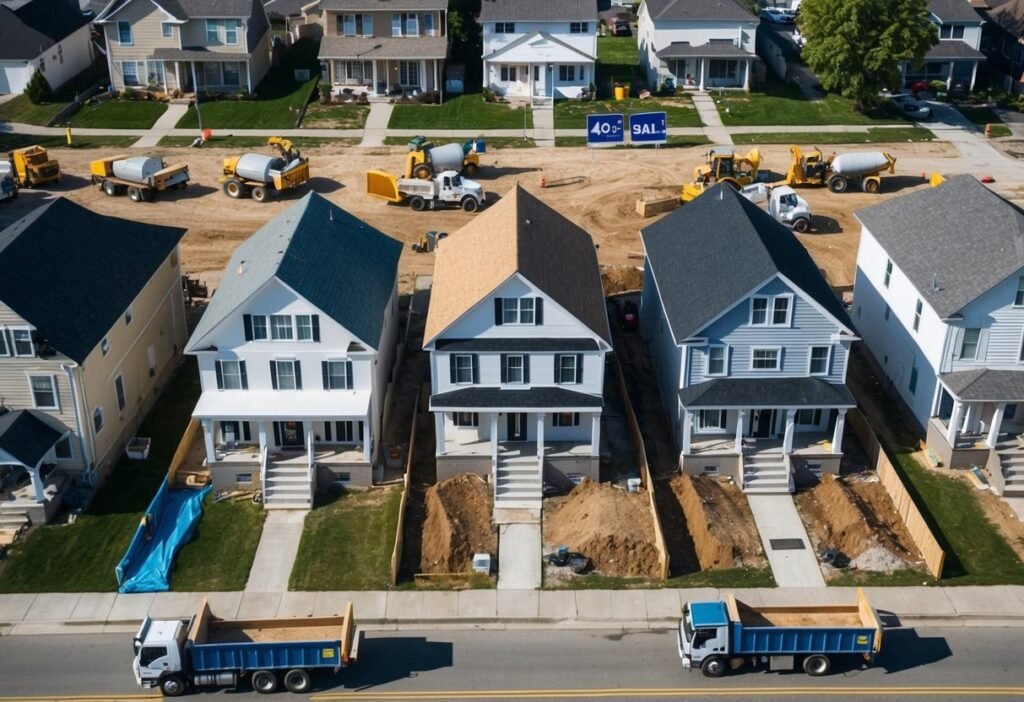Flipping houses successfully depends on more than finding a good property—you also need to understand where the next profitable opportunities are emerging. To maximize your returns, you must learn how to analyze neighborhood trends to identify areas with real growth potential and minimize risk. Smart investors track indicators like local market appreciation, job growth, and access to amenities to make informed decisions about where to invest next.
By carefully observing shifts in property values, population changes, and the reputation of different communities, you can spot up-and-coming neighborhoods before they peak. Reliable market data and actionable strategies help you avoid stagnant areas and make the most of your investment.
Key Takeaways
- Evaluating local market trends is essential for flipping success.
- Neighborhood data reveals where profitable flips are most likely.
- Informed analysis leads to better investment outcomes.
Core Factors in Analyzing Neighborhood Trends for Flipping
Pinpointing the right neighborhoods to flip homes requires evaluating data on pricing, buyer demand, local development, and competitive dynamics. Small changes in demographics, job growth, and new infrastructure often point to areas with strong appreciation rates and higher profit margin potential for real estate investors.
Understanding Market Trends
Effective market analysis begins with tracking real estate trends at both citywide and neighborhood levels. Focus on metrics like median home values, days on market, and historical appreciation rates.
Review how prices have changed over a 3- to 5-year period. Rapid increases in values may signal growing demand, while flattening or falling prices can mean declining interest or over-supply. A spike in flipping rate or renovations is often a sign that home flippers are active and confident about returns.
Keep an eye on local housing market reports and economic data for metro areas. Infrastructure projects, new businesses, and improved transit can all drive demand. Resources that track property price trends can help you spot neighborhoods “on the rise” before they peak. Summarize your findings to determine if the local market fits your flipping strategy.
Evaluating Demographics and Location
Demographics play a significant role in determining a neighborhood’s investment potential. Factors like population growth, household income levels, and educational attainment help predict both short-term activity and longer-term appeal.
Identify areas attracting young professionals or families, as these groups often drive sustained demand. Walkability, proximity to major employers, and access to public transit boost an area’s desirability. You’ll also want to consider local amenities, school quality, and crime rates.
Emerging neighborhoods adjacent to prime locations tend to offer the best mix of appreciation and affordability. To analyze these variables systematically, make use of data tables with columns such as population growth rate, median income, average commute times, school ratings, and walk scores.
Assessing Competition and Local Real Estate Market
Understanding the level of competition and the broader local real estate market context is critical for home flippers. Study the number of active listings, recent sales volume, and how long properties remain on the market.
Areas with a low supply of homes and high buyer demand are more favorable for flipping, as bidding wars can push prices higher and shorten holding times. On the other hand, neighborhoods saturated with other real estate investors can create tight margins and slow down sales.
Look for information on new listings, investor activity, and trends in renovation permits. Use this data along with historical neighborhood appreciation rates to evaluate which markets have sustainable demand and room for margins to grow. For more tips on analyzing appreciation and competition, see this guide on neighborhood appreciation rates for house flipping success.
Applying Neighborhood Data to Maximize Flipping Success
Successfully flipping homes requires more than simply identifying undervalued properties. To make informed decisions, you need to analyze neighborhood data, consider the financial implications of renovations, and strategically position your property for resale.
Leveraging Real Estate Analytics and Data Sources
Harnessing real estate analytics gives you an edge in pinpointing profitable investment opportunities. Use tools like Zillow, Redfin, and local real estate agent reports to study recent home sales, property values, and median resale prices in specific neighborhoods. Accurate data on age, income, education, and lifestyle trends helps you understand your target market’s preferences and purchasing power.
Review public records for permits and zoning changes, which can signal upcoming growth or regulatory hurdles. Monitoring industry news and U.S. home flipping reports keeps you aware of new profit trends and potential risks. Networking with real estate agents and property management professionals helps you gather practical insights on market shifts, structural integrity issues, and the demand for eco-friendly homes.
Comparing historical appreciation rates and current market cycles allows you to choose neighborhoods with upward trajectories. Regular competitive analysis ensures you assess ongoing changes and recognize when neighborhoods lose their flipping potential.
Balancing Renovation Costs and Return on Investment (ROI)
Managing renovation expenses directly impacts your gross profit margins. Start by accurately estimating repair costs and addressing any structural integrity problems or outdated systems, as these can quickly inflate your budget. Consider the target market’s interests and lifestyles—energy-efficient upgrades or modern amenities may be necessary to maximize returns in some neighborhoods.
Calculate your expected return on investment (ROI) by weighing total renovation costs against projected resale prices. Be mindful of hidden costs such as permits, carrying costs, and property taxes that accumulate during the holding period. Evaluate whether the investment aligns with current profit trends in the flipping industry and whether you can achieve a positive gross profit.
Maintain a detailed budget tracking system for all renovation work to ensure you stay within financial targets. Use past flipping data and industry benchmarks to assess whether your planned improvements reflect local home value expectations and resale potential.
Setting the Right Price and Monitoring Resale Values
Pricing your flip accurately requires a blend of market analysis and competitive insight. Look at recent comparable home sales within the neighborhood, factoring in the features and upgrades you have added. Use real estate data services and input from real estate agents to establish a listing price that appeals to your target market while targeting strong investment returns.
Stay updated on changes in home prices and median resale prices throughout the listing period. If necessary, adjust your asking price based on shifts in demand, buyer feedback, or emerging listings in your area.
Track your own performance against local profit trends by calculating your final gross profits after the sale. Continuous evaluation of resale values enables you to refine your process and make better-informed decisions on future flips, safeguarding against market volatility.
Frequently Asked Questions

Understanding neighborhood trends is essential for investors aiming to maximize profits in house flipping. Various factors, including property data, local economic conditions, and community development plans, all affect investment outcomes.
What are the key indicators of a neighborhood’s potential for property flipping success?
You should look for increasing property values, declining vacancy rates, and recent infrastructure improvements. Signs like new businesses opening, well-maintained houses, and safety improvements often signal positive momentum in an area. Monitoring these indicators helps identify areas likely to appreciate.
How does one effectively assess the real estate market when considering a neighborhood for flipping?
Examine current and historical sales data, average days on market, and comparable sales within the neighborhood. Talk to local real estate agents and track homeowner versus renter ratios for additional insight. Local news and real estate websites can provide updates on emerging neighborhoods and trends.
What are the risks and challenges commonly associated with flipping houses in emerging neighborhoods?
You may face uncertain property values, less predictable demand, and variable resale timelines. Neighborhoods in transition can present issues such as fluctuating crime rates, delays in community improvements, or oversupply from speculative investors. Conducting thorough due diligence is necessary to minimize these risks.
How can historical and predictive data analysis be utilized in selecting neighborhoods for property investment?
Reviewing historical appreciation rates and property sales trends can reveal patterns in price growth or stagnation. Predictive analytics that factor in job growth, population shifts, and planned developments can help forecast future changes. For a more detailed approach, you can learn more about analyzing appreciation rates for investment decisions.
What role do local economic factors play in the successful flipping of properties in a given neighborhood?
Job growth, local business expansion, and access to transportation influence home demand and values. Areas with strong schools and stable employment attract more buyers, increasing the potential for faster and more profitable flips. Economic challenges in a region can limit pool of interested buyers and slow sales.
In what ways can community development plans affect the profitability of flipping houses in a specific area?
New zoning changes, infrastructure upgrades, and planned public amenities often improve long-term property values. Projects such as new parks, transit stations, or retail developments can boost neighborhood desirability and support higher resale prices. However, planned projects that fail to materialize can introduce risk for investors.
Tired of second-guessing your investment numbers?
Learn how to find profitable real estate deals.
Get instant access to professional-grade property analysis tools from DealCheck.io and start evaluating properties in minutes!

Dive deep into the world of real estate investment with this comprehensive case study that brings theory to life.
Investment Real Estate Analysis: A Case Study offers an unparalleled look at the decision-making process behind successful property investments. Follow along as we dissect a real-world scenario, revealing the critical factors that seasoned investors consider before making a move.
From crunching numbers to assessing market conditions, this book walks you through every step of the analysis process. Learn how to evaluate potential investments like a pro, understanding key metrics such as cap rates, cash-on-cash returns, and internal rate of return.
Whether you’re a novice investor or looking to refine your skills, this case study will equip you with the tools to make informed investment decisions in the competitive real estate market.
Get your copy now from your favorite bookseller:
- Amazon
- Books2Read for Apple, Barnes & Noble, Kobo, Scribed, and 8 more sellers with both eBook and paperback options available
- Payhip as a downloadable PDF






